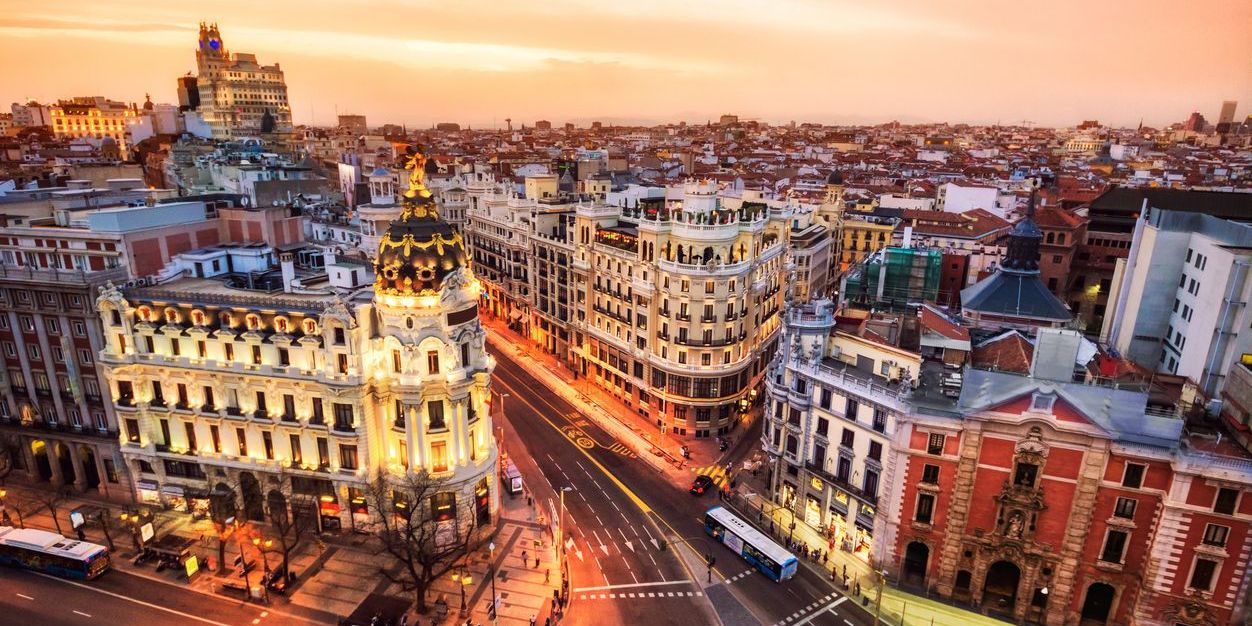If you are coming to the capital of Spain, the important thing is that you know exactly how to get to Madrid and which option suits you according to your budget, your time, and where you are coming from.
That’s why today we are going to explain where to enter by car, what you should keep in mind with the Low Emission Zone (ZBE), and what real alternatives you have by train, bus, and plane, with indicative times and prices for you to compare.
How to get to Madrid by Car
Entering Madrid by road is easy. There are six main routes that connect the city with the rest of the cities in Spain.
If you are coming from the north, your natural path is to follow the A-1; from the northeast, the A-2 —Zaragoza-Barcelona—; from the east, the A-3 —Valencia—; from the south, the A-4 —Córdoba-Sevilla—; from the southwest, the A-5 —Extremadura-Portugal—; and from the northwest, the A-6 —Castilla y León-Galicia—.
As you get closer to the capital, things get difficult. You will see the rings: the M-50, the most external and useful for skirting without entering; the M-40, intermediate, very practical for choosing the best access to your neighborhood; and the M-30, interior, which embraces the center and combines sections on the surface with very long tunnels.
If your destination is outside the center, skirt the city on the M-50 or M-40 and enter through the link that suits you best; and if it is inside, use the M-30 to get closer and exit through the most logical branch towards your area.
Now you know how to get to Madrid by car, but before you come you should check the ZBE and make sure you can drive.
And what cars can enter Madrid? Here is a quick summary:
- Without a badge: if your car does not have an environmental badge —category A—, from 2025 you cannot access or drive through a large part of the municipality.
- Label B, C, ECO or CERO: you can drive normally, but always check the current conditions in case there are exceptions, holidays, or warnings due to high pollution.
This way you will avoid scares, detours, and fines that will ruin your trip. And if you prefer not to drive to the center, an effective strategy is to park next to the Metro or Cercanías —north, south, east, or west periphery— and continue by public transport.
Alternatives to get to Madrid: Train, Bus, and Plane
If you are coming from another capital or large city, the train is usually the fastest way. Between Barcelona and Madrid, the fastest services are around two and a half hours, from Valencia almost two hours, and from Zaragoza only an hour and a half.
Which operators can you take the trip with? With Renfe AVE/Avlo, OUIGO, or Iryo, among others. This means that there are many different frequencies and prices. The good thing about the train is that it leaves you at Atocha or Chamartín, both stations are inside the city and well connected with Metro and Cercanías.
The bus is your option if you want to spend little and don’t mind taking longer. As a reference, a direct Barcelona-Madrid usually takes around seven hours and there are several departures a day. The capital concentrates long-distance buses at Estación Sur —Méndez Álvaro—, Avenida de América, Plaza Elíptica, Príncipe Pío, and Moncloa, all with Metro and some of them with Cercanías.
If you are coming from another European city, the islands, or from further away, the plane is the most logical transport. You will land at Adolfo Suárez Madrid-Barajas (MAD), a huge airport with four terminals. To get to the center you have three options: the 24-hour Airport Express —direct bus to Cibeles-Atocha with a flat rate—, the Metro —line 8 with an airport supplement— and Cercanías —C-1 or C-10—.
Another option is to use a taxi with a fixed rate, but it only pays off if you travel with more people.
How to get to Madrid: Price Comparison
So that you can choose wisely how to get to Madrid, keep these indicative references —they depend on the day, the time, and the advance notice— of how much it may cost you.
If you come by train, in addition to saving time because it leaves you in the center and you avoid the hidden times of the plane —transfer to the airport, control, and waits— you will also save money. With offers you can see tickets from €15, but assume that it will be normal to pay something more —even up to €150—. Competition between operators favors you: compare and choose.
If you prioritize budget over time, the bus wins. The advantage is that it usually costs less than the train without the offers, that there are many frequencies, and that the night buses make you arrive early to the capital without losing a day of travel.
The plane is unbeatable over very long distances or if you come from another country. Between peninsular cities, the flight can last about 50 or 80 minutes, but you must add: travel to the airport, control, boarding, and departure. In addition, once in Madrid, from Barajas to the center it will take about 30 or 45 minutes to the center. However, the price can be a lottery.
Within Spain, the cost of flights with offers starts from €12 and can reach €250. From any other city in Europe, a flight to Madrid will cost you between €20 and €500. Yes, the range is very wide. And from the USA, Canada, Latin America, Oceania, or Asia it could cost you between €600 and €1,400.
When looking for how to get to Madrid by car, the price fluctuates more, much more: tolls, the price of gasoline, and the area of the peninsula from which you leave will influence, but it should not exceed €140 in total.

What to Do when You Arrive in Madrid
As soon as you arrive, get situated quickly to start enjoying. And, in addition to the essentials of what to see in Madrid in 3 days —or however long you come for— such as the Prado Museum, the Plaza Mayor, the Puerta del Sol, the Retiro, and the Temple of Debod, among others, you have to write down some more plans that will catapult your getaway to Madrid.
Although it sounds a bit strange at first, one of the activities that we highly recommend is enjoying a flamenco show in Madrid; and if it doesn’t fit your style, replace it with an afternoon or evening in one of the best musicals or plays in Madrid.
And if you have an extra day and have come this far looking for how to get to Madrid by car, you’re in luck! From the center of the city and with a vehicle at your disposal, you can get closer to some of the beautiful villages near Madrid. None of them are a waste.

Are You Coming to Madrid?
Now you know how to get to Madrid and which option suits you best in time and money, and you have the best thing left: enjoy a city that is alive at any time of the day, which is easy to get around and which always has plans to offer you, whether you come for the first time or repeat and want to squeeze it to the fullest.
Do you want to stay in one of the best neighborhoods in Madrid to make getting to know the city even easier? We make it very easy for you with our apartments and flats in the center of the city so you can book in a couple of minutes and without complications.
Searching for how to get to Madrid has been easy; staying with WAOU RENTALS, even more so.

Spectacular duplex apartment steps from Puerta del Sol, Madrid Centre
From 250.00€ per night

Impressive apartment near Puerta del Sol, Madrid Centre
From 250.00€ per night

Design apartment next to Plaza España and Madrid Río, Madrid Centre
From 90.00€ per night

Design apartment next to Plaza España and Madrid Río, Madrid Centre
From 90.00€ per night


